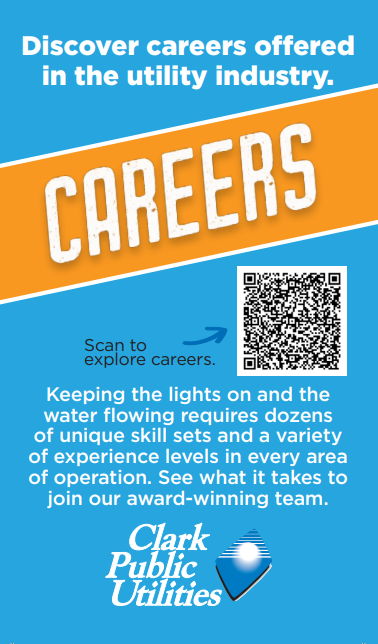A card with a QR Code developed by Washington State’s Clark Public Utilities is a simple, low-effort, low-cost outreach tool that has the potential to create highly effective results in the PUD’s workforce recruitment efforts, said Dameon Pesanti, Public Information Officer at Clark Public Utilities.
The idea for the card grew out of a regular meeting of the public power utility’s Communications Department last year, noted Pesanti.
“Our group was talking about a recent wave of retirements at the utility and that led to a broader discussion about retention and recruitment outreach. We talked about having something quick and easy for employees to hand out when they were impressed by the service or assistance from a person in the community,” he said.
“Someone brought up these ‘assistance is available’ cards we previously created to get the word out about our assistance programs. Then it was decided to have it be the two-sided deal so it could serve” a dual function as a link to actual open job listings “and the other side the link to more information about what it’s like working at the utility in general,” Pesanti said.
Pesanti described the advantages of the card in terms of Clark Public Utilities workforce recruitment efforts.
It’s a simple, low-effort, low-cost outreach tool that has the potential to create highly effective results in the utility’s effort to staff its organization with top-quality people from around the community, he noted.

“They fit in a wallet, can be carried by anyone and handed out just about anywhere. At a minimum, they offer a chance to build good impressions of the utility with individuals in the community.”
Even if someone isn’t looking for a job, “they may think higher of our entire organization when one of our employees thought highly of them to pass the card along,” he said.
It’s also a reminder that Clark Public Utilities “is here as an employer when they’re ready for new opportunities.”
One QR code “sends them to a page about the different roles we have and the other takes them directly to our jobs page.”
Once people land on the actual job listing page, “even if something doesn’t look up their alley, they can sign up for an email alert whenever a new job listing is posted. It seems inconsequential, but having the QR codes on it greatly simplifies the process for a potential candidate to visit our website and learn about us.”
When asked how the community has responded to this workforce recruitment effort, Pesanti said the tool is still young, but early results are promising.
“It’s been something of a soft launch among Communications and Employee Resources staff. Our employees who use them at job fairs and industry fairs say they have great uptake,” he said.
They also serve as kind of a bridge in those moments “when we can’t take resumes or don’t have openings for job seekers. Rather than ending the conversation with a simple no, the card is a way to say, not now, but check back with us.”
The QR codes “enable us to track how many people use them to view our jobs page. It’s not a perfect tool to track every person that’s used the card, since they can type the URL in the old fashioned way, but even a modest number of code users should give us good insight” into the effectiveness of the card overall, he noted.
Clark Public Utilities provides electricity service to more than 225,000 customers throughout Clark County, Wash., and water service to about 39,000 homes and businesses in unincorporated areas.

